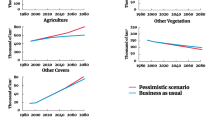Abstact
More and more lands worldwide are being cultivated for food production while forests are disappearing at an unprecedented rate. This paper aims to make a long-term forecast on land uses worldwide and provide the publics, researchers, and government officials with a clear profile for land uses in the future. Data of land uses since 1961 were used to fit historical trajectories and make the forecast. The results show that trajectories of land areas can be well fitted with univariate linear regressions. The forecasts of land uses during the coming 25 years were given in detail.
Areas of agricultural land, arable land, and permanent pasture land worldwide would increase by 6.6%, 7.2%, and 6.3% respectively in the year 2030 as compared to the current areas. Permanent crops land area all over the world is forecasted to increase 0.64% by 2030. By the year 2030 the areas of forests and woodland, nonarable and nonpermanent land worldwide would decrease by 2.4% and 0.9% against the current areas. All other land area in the world would dramatically decline by 6.4% by the year 2030.
Overall the land area related to agriculture would tend to decrease in developed countries, industrialized countries, Europe, and North and Central America. The agriculture related land area would considerably increase in developing countries, least developed countries, low-income countries, Asia, Africa, South America, etc.
Developing countries hold larger total land area than developed countries. Dramatic and continuous growth in agricultural land area of developing countries would largely contribute to the expected growth of world agricultural land area in the coming years. Population explosion, food shortage and poverty in the world, especially in developing countries, together caused the excessive cultivation of land for agricultural uses in the past years. Increasing agricultural land area exacerbates the climate changes and degradation of environment. How to limit the growth of human population is a key problem for reducing agricultural land expansion. Development and use of high-yielding and high-quality crop and animal varieties, diversification of human food sources, and technical and financial assistance to developing countries from developed countries, should also be implemented and strengthened in the future in order to slow down or even reverse the increase trend of agricultural land area. Sustainable agriculture is the effective way to stabilize the agricultural land area without food shortage. Through various techniques and measures, sustainable agriculture may meet the food production goals with minimum environmental risk. Public awareness and interest in sustainable agriculture will help realize and ease the increasing stress from agricultural land expansion.
Similar content being viewed by others
References
Altieri, M. A.: 1995, Agroecology: The Science of Sustainable Agriculture, Westview Press, Boulder, Co.
FAO, FAOSTAT: AGRICULTURE, 2005.
Girgg, O. B.: 1993, The World Food Problem, Blackwell, Oxford.
IRRI: 2005, GreenRice.net: Toward an Environmental Agenda, International Rice Research Institute.
Lavelle, P., Gilot, C., Fragoso, C. and Pashanasi, B.: 1994, Soil Resilience and Sustainable Land Use, CAB International, Wallingford, UK.
Matson, P. A., Parton, W. J., Power, A. G. and Swift, M. J.: 1997, ‘Agricultural intensification and ecosystem properties’, Science 277, 504–509.
Power, A. G.: 1996, Forest Patches in Tropical Landscapes, Island Press, Washington, DC.
SPSS Inc.: 2001, SPSS for Windows 11.0.0.
Tilman, D., Fargione, J. and Wolff, B. et al. 2001, ‘Forecasting agriculturally driven global environmental change’, Science 292, 281–284.
Vandermeer, J.: 1989, The Ecology of Intercropping, Cambridge University Press, New York.
Way, M. J. and Heong, K. L.: 1994, ‘The role of biodiversity in the dynamics and management of insect pests of tropical irrigated rice-a review’, Bulletin of Entomological Research 84, 567–587.
Western, D. and Pearl, M. C.: 1989, Conservation for the Twenty-first Century, Oxford University Press, New York.
Zhang, W. J., Qi, Y. H. and Liu, Y. L.: 2004, ‘An elementary forecast on trend of rice production of the world and regions’, Agrolook 5(3), 8–11.
Author information
Authors and Affiliations
Corresponding author
Rights and permissions
About this article
Cite this article
Zhang, W., Qi, Y. & Zhang, Z. A Long-Term Forecast Analysis On Worldwide Land Uses. Environ Monit Assess 119, 609–620 (2006). https://doi.org/10.1007/s10661-005-9046-z
Received:
Accepted:
Published:
Issue Date:
DOI: https://doi.org/10.1007/s10661-005-9046-z




